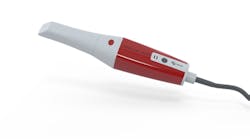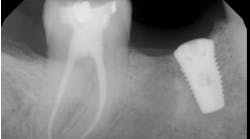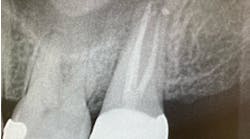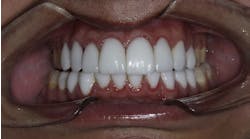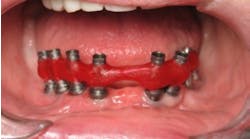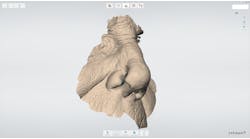On many occasions, patients present to our offices with teeth lacking sufficient coronal tooth structure. Whether the loss of structure is due to caries or trauma, the remaining structure must have certain dimensions to aid in the resistance form of our crown preparations. This is imperative to prevent the complication of tooth/root fracture.
The term “ferrule effect” is one many dentists take into account while examining a tooth for restorability. This term is mentioned in Shillingburg’s classic prosthodontic textbook, “Fundamentals of Fixed Prosthodontics” ...
When all tooth structure has been lost to the level of the alveolar crest or beyond, because of either fracture or caries, the tooth cannot be satisfactorily restored without some extraordinary measure. Even if a dowel core is placed in the tooth, the root will remain susceptible to fracture without the crown encircling the tooth apical to the core. This ferrule effect around the tooth protects it from fracture by the dowel from within.”
Another way to incorporate remaining tooth structure is when evaluating a tooth for crown lengthening. The classic text for periodontics, “Carranza’s Clinical Periodontology,” mentions ferrule effect and its dimensions ...
If a tooth fracture extends to the level of the bone, it must be erupted 4 mm. The first 2.5 mm moves the fracture margin far enough away from the bone to prevent a biologic width problem. The other 1.5 mm provides the proper amount of ferrule for adequate resistance form of the crown preparation.
As defined by “The Glossary of Prosthodontic Terms” ...
fer_rule fe˘ r#al n (15c) l: a metal band or ring used to fit the root or crown of a tooth. One way to visualize this effect is when observing a wine barrel. The metal bands or hoops, which encompass the wooden barrel, give support when the barrel is full.
The dimension needed to allow this encircling metal has been reported in the literature numerous times. One classic study by Sorensen not only summarizes the purpose of a dowel, but also concludes a critical dimension in order to create this effect: One millimeter of coronal dentin above the shoulder significantly increased the failure threshold. Once again, an increase in resistance form caused by the metal collar and the parallel dentin axial walls.
This critical dimension is mentioned in various dimensions, but is best summarized by Morgano ...
Current knowledge has confirmed that the dentist should retain as much coronal tooth structure as possible when preparing pulpless teeth for complete crowns to maximize the ferrule effect. A minimal height of 1.5 mm to 2 mm of intact tooth structure above the crown margin for 360 degrees around the circumference of the tooth preparation appears to be a rational guideline for this ferrule effect. Surgical crown lengthening or orthodontic extrusion should be considered with severely damaged teeth to expose additional tooth structure to establish a ferrule.
So, when evaluating the remaining tooth structure, this summary should help restorative dentists remember critical dimensions and reasons for why we look to create the ferrule effect in our tooth preparations. This summary should hopefully also help with surgical procedures to help guide in dimensions for crown lengthening.
Author bio
Brandon G. Katz, DDS, is a graduate of New York College of Dentistry, class of 2008. Upon completing his General Practice Residency at Stony Brook University Hospital in 2009, Dr. Katz trained in postgraduate prosthodontics, earning a certificate in prosthodontics from the Manhattan VA Medical Center in 2012. Currently, Dr. Katz is enrolled in the postgraduate program in periodontics at Stony Brook School of Dental Medicine, and works in private practice in his free time.
References
• Shillingburg Jr., Herbert T. Fundamentals of Fixed Prosthodontics, 3rd Edition. Quintessence Publishing (IL), 011997. p. 191.
• Newman, Michael G. Carranza's Clinical Periodontology, 10th Edition. Saunders Book Company, 072006. p. 865.
• The Glossary of Prosthodontic Terms – Eighth Edition. JPD. 2005; 94:10-92.
• Sorensen J, Engelman M. Ferrule design and fracture resistance of endodontically treated teeth. JPD. 1990; 63:529-536.
• Morgano S, Brackett S. Foundation restorations in fixed prosthodontics: Current knowledge and future need. JPD. 1999; 82:643-657.

